| |
 |
 |
 |
|
 |
 |
 |
 |
 |

|
 |
 |
|
|
|
 |
During Earthquakes, Mineral Gel May Reduce Rock Friction to Zero
|
 |
| |
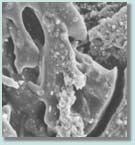 Researchers have discovered a mineral gel created when rocks abrade each other under earthquake-like conditions. If present in faults during a quake, the gel may reduce friction to nearly zero in some situations, resulting in larger energy releases that could cause more damage. Terry Tullis and David Goldsby of Brown University in Providence, R.I., and Giulio Di Toro of the University of Padova in Italy announced their findings in the Jan. 29 issue of the journal Nature. The researchers sheared quartz-rich rocks against each other under controlled conditions, simulating several aspects of a geologic fault environment. Future experiments will take advantage of a salvaged 100-horsepower BMW motorcycle engine, which will allow the apparatus to reach seismic slip speeds of one meter per second. Researchers have discovered a mineral gel created when rocks abrade each other under earthquake-like conditions. If present in faults during a quake, the gel may reduce friction to nearly zero in some situations, resulting in larger energy releases that could cause more damage. Terry Tullis and David Goldsby of Brown University in Providence, R.I., and Giulio Di Toro of the University of Padova in Italy announced their findings in the Jan. 29 issue of the journal Nature. The researchers sheared quartz-rich rocks against each other under controlled conditions, simulating several aspects of a geologic fault environment. Future experiments will take advantage of a salvaged 100-horsepower BMW motorcycle engine, which will allow the apparatus to reach seismic slip speeds of one meter per second.
Image credit: Terry Tullis, Brown University; NSF
Read the full story . ... Posted
1/30/04
|
 |
President Signs Consolidated Spending Bill; NSF Budget Rises to $5.57 Billion for FY2004
|
 |
| |
 On January 23, President Bush signed into law a $328-billion spending bill that includes $5.57 billion for the National Science Foundation. The President's action came one day after the Senate passed the bill by a vote of 65 to 28. The appropriation for NSF represents an increase of about $267 million, or 5.0 percent, over the FY 2003 funding level, and nearly $97 million more than the FY2004 budget request. The consolidated spending bill funds the operations of most of the federal government through September 30, 2004. The House of Representatives approved it last December, but a number of controversial provisions held up a Senate vote. On January 23, President Bush signed into law a $328-billion spending bill that includes $5.57 billion for the National Science Foundation. The President's action came one day after the Senate passed the bill by a vote of 65 to 28. The appropriation for NSF represents an increase of about $267 million, or 5.0 percent, over the FY 2003 funding level, and nearly $97 million more than the FY2004 budget request. The consolidated spending bill funds the operations of most of the federal government through September 30, 2004. The House of Representatives approved it last December, but a number of controversial provisions held up a Senate vote.
Image: Getty Images/PhotoDisc
Read the full story . ... Posted
1/26/04
|
 |
Protein Data Bank Opens New Era With Broader Support; Nearly 24,000 molecules and growing, accessible collection advances
biology
|
 |
| |
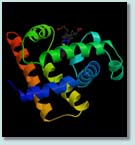 The assets of the Protein Data Bank (PDB) just keep growing. The PDB holds the three-dimensional structures of nearly 24,000 proteins and other macromolecules in its growing – and publicly accessible – collection. Its holdings profile DNAs, RNAs, viruses, and various proteins, such as enzymes central to photosynthesis, growth, development and brain function. This month, with a doubling in the number of the federal agencies supporting it, the PDB begins a new five-year, $30 million management era, the National Science Foundation announced on Jan. 21. The chapter opens following a new international agreement announced last month to pool and coordinate the deposit of molecular structure data globally. The assets of the Protein Data Bank (PDB) just keep growing. The PDB holds the three-dimensional structures of nearly 24,000 proteins and other macromolecules in its growing – and publicly accessible – collection. Its holdings profile DNAs, RNAs, viruses, and various proteins, such as enzymes central to photosynthesis, growth, development and brain function. This month, with a doubling in the number of the federal agencies supporting it, the PDB begins a new five-year, $30 million management era, the National Science Foundation announced on Jan. 21. The chapter opens following a new international agreement announced last month to pool and coordinate the deposit of molecular structure data globally.
Image credit: The Protein Data Bank
Read the full story . ... Posted
1/22/04
|
 |
Nanoscale Building Blocks Form Spheres, Tubes and Curves; Self-assembling structures could find wide use in nanoelectronics and drug delivery
|
 |
| |
 Inspired by the molecular assembly techniques used in living cells, chemist Chad Mirkin and his colleagues at Northwestern University have created a new class of nanometer-scale building blocks that can spontaneously assemble themselves into ultra-tiny spheres, tubes and curved sheets. This is the first time that scientists have been able to make structures on this scale that curve in any fashion, as opposed to being straight or flat. Since the Mirkin group can also control the size and curvature of their structures very accurately, the technology could eventually lead to important applications in nanoscale electronics and drug-delivery systems. Inspired by the molecular assembly techniques used in living cells, chemist Chad Mirkin and his colleagues at Northwestern University have created a new class of nanometer-scale building blocks that can spontaneously assemble themselves into ultra-tiny spheres, tubes and curved sheets. This is the first time that scientists have been able to make structures on this scale that curve in any fashion, as opposed to being straight or flat. Since the Mirkin group can also control the size and curvature of their structures very accurately, the technology could eventually lead to important applications in nanoscale electronics and drug-delivery systems.
Image credit: Chad Mirkin, Northwestern University
Read the full story . ... Posted
1/16/04
|
 |
Study Pinpointing Origins of Siberian Peat Bogs Raises Concerns that Arctic Thaw May Release Greenhouse Gases
|
 |
| |
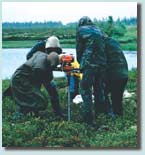 Massive Siberian peat bogs, widely known as the permanently frozen home of untold kilometers of moss and uncountable hordes of mosquitoes, also are huge repositories for gases that are thought to play an important role in the Earth's climate balance, according to newly published research by a team of U.S. and Russian scientists in the Jan. 16 edition of the journal Science. Those gases, carbon dioxide and methane, are known to trap heat in the Earth's atmosphere, but the enormous amounts of the gases contained in the bogs haven't previously been accounted for in climate-change models. The new research, said Laurence Smith, an associate professor at the University of California, Los Angeles and a primary author on the paper, could help to refine those materials. Massive Siberian peat bogs, widely known as the permanently frozen home of untold kilometers of moss and uncountable hordes of mosquitoes, also are huge repositories for gases that are thought to play an important role in the Earth's climate balance, according to newly published research by a team of U.S. and Russian scientists in the Jan. 16 edition of the journal Science. Those gases, carbon dioxide and methane, are known to trap heat in the Earth's atmosphere, but the enormous amounts of the gases contained in the bogs haven't previously been accounted for in climate-change models. The new research, said Laurence Smith, an associate professor at the University of California, Los Angeles and a primary author on the paper, could help to refine those materials.
Image credit: Laurence C. Smith / National Science Foundation
Read the full story . ... Posted
1/16/04
|
 |
A Possible New Form of "Supersolid" Matter; Frozen helium-4 behaves like a combination of solid and superfluid
|
 |
| |
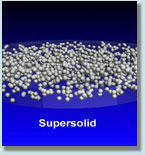 Researchers at the Pennsylvania State University are announcing the possible discovery of an entirely new phase of matter: an ultra-cold, "supersolid" form of helium-4. Writing in the January 15 issue of the journal Nature, Penn State physicist Moses H. W. Chan and his graduate student, Eun-Seong Kim, explain that their material is a solid in the sense that all its helium-4 atoms are frozen into a rigid crystal lattice, much like the atoms and molecules in a normal solid such as ice. The difference is that "frozen," in this case, doesn't mean "stationary." Researchers at the Pennsylvania State University are announcing the possible discovery of an entirely new phase of matter: an ultra-cold, "supersolid" form of helium-4. Writing in the January 15 issue of the journal Nature, Penn State physicist Moses H. W. Chan and his graduate student, Eun-Seong Kim, explain that their material is a solid in the sense that all its helium-4 atoms are frozen into a rigid crystal lattice, much like the atoms and molecules in a normal solid such as ice. The difference is that "frozen," in this case, doesn't mean "stationary."
Image credit: Trent L. Schindler / National Science Foundation
Read the full story . ... Posted
1/14/04
|
 |
Chemists Crack Secrets of Nature's Super Glue; Mussel-powered proteins stick to Teflon, even under water
|
 |
| |
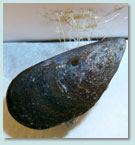 Researchers have discovered that iron in seawater is the key binding agent in the super-strong glues of the common blue mussel, Mytilus edulis. This is the first time researchers have determined that a metal such as iron is critical to forming an amorphous, biological material. In addition to using the knowledge to develop safer alternatives for surgical and household glues, the researchers are looking at how to combat the glue to prevent damage to shipping vessels and the accidental transport of invasive species, such as the zebra mussel that has ravaged the midwestern United States. National Science Foundation CAREER awardee Jonathan Wilker, Mary Sever and their colleagues at Purdue University announced their discovery in the Jan. 12 issue of Angewandte Chemie. Researchers have discovered that iron in seawater is the key binding agent in the super-strong glues of the common blue mussel, Mytilus edulis. This is the first time researchers have determined that a metal such as iron is critical to forming an amorphous, biological material. In addition to using the knowledge to develop safer alternatives for surgical and household glues, the researchers are looking at how to combat the glue to prevent damage to shipping vessels and the accidental transport of invasive species, such as the zebra mussel that has ravaged the midwestern United States. National Science Foundation CAREER awardee Jonathan Wilker, Mary Sever and their colleagues at Purdue University announced their discovery in the Jan. 12 issue of Angewandte Chemie.
Image courtesy: Jonathan Wilker of Purdue University, NSF
Read the full story . ... Posted
1/12/04
|
 |
RNA Lariat May Tie Up Loose Ends to Decades-Old Mystery of Retrovirus Life Cycle; Studies of baker's yeast may lead to new drugs to fight HIV
|
 |
| |
 Studies on common baker's yeast have led to the discovery of what may be a long-sought mechanism in the life cycle of retroviruses, including the human immunodeficiency virus (HIV). Knowing the details of this step in the infection process could help pinpoint targets for new classes of drugs to fight HIV. In the Jan. 9 issue of the journal Science, Thomas Menees and Zhi Cheng of the University of Missouri—Kansas City describe the formation of a lariat structure with the genetic material of retrovirus-like elements in baker's yeast and subsequent cutting of the lariat by a yeast enzyme. "The work of Menees and his collaborators fills a real void in our understanding of how retroviruses propagate and how genetic information is faithfully copied," said Patrick Dennis, program director for microbial genetics at the National Science Foundation, which supported the research. "The RNA lariat provides a plausible mechanism for a key step that has remained a mystery since the process of reverse transcription was first presented almost 35 years ago." Studies on common baker's yeast have led to the discovery of what may be a long-sought mechanism in the life cycle of retroviruses, including the human immunodeficiency virus (HIV). Knowing the details of this step in the infection process could help pinpoint targets for new classes of drugs to fight HIV. In the Jan. 9 issue of the journal Science, Thomas Menees and Zhi Cheng of the University of Missouri—Kansas City describe the formation of a lariat structure with the genetic material of retrovirus-like elements in baker's yeast and subsequent cutting of the lariat by a yeast enzyme. "The work of Menees and his collaborators fills a real void in our understanding of how retroviruses propagate and how genetic information is faithfully copied," said Patrick Dennis, program director for microbial genetics at the National Science Foundation, which supported the research. "The RNA lariat provides a plausible mechanism for a key step that has remained a mystery since the process of reverse transcription was first presented almost 35 years ago."
Image credit: Trent Schindler / National Science Foundation
Read the full story . ... Posted
1/8/04
|
 |
Clean Water, Safe Cars and Powerful Electronics; Researchers, Business Leaders Celebrate 30th Anniversary of NSF Industry/University Cooperative Research Centers Program
|
 |
| |
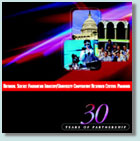 From pipelines and power grids to simulators and "smart dust," National Science Foundation-supported collaborations have led to research breakthroughs important to industry and universities. Next week, in a two-day conference, "30 Years of Partnership: Past Successes and New Challenges in Cooperative Research," NSF will highlight past successes and future advances arising from the Industry/University Cooperative Research Centers (I/UCRC) Program. The program develops long-term partnerships among industry, academe, and government. The conference will showcase presentations from researchers and industry, along with keynote addresses from Joe Bordogna, deputy director of NSF; U.S. Congressman Nick Smith of Michigan’s 7th district and chair of the House Subcommittee on Research; John White, Jr., National Science Board member and chancellor of the University of Arkansas; Kathleen Kingscott, director of public affairs for IBM Corp.; and David Tennenhouse, vice president of the Corporate Technology Group and director of research for Intel Corp. From pipelines and power grids to simulators and "smart dust," National Science Foundation-supported collaborations have led to research breakthroughs important to industry and universities. Next week, in a two-day conference, "30 Years of Partnership: Past Successes and New Challenges in Cooperative Research," NSF will highlight past successes and future advances arising from the Industry/University Cooperative Research Centers (I/UCRC) Program. The program develops long-term partnerships among industry, academe, and government. The conference will showcase presentations from researchers and industry, along with keynote addresses from Joe Bordogna, deputy director of NSF; U.S. Congressman Nick Smith of Michigan’s 7th district and chair of the House Subcommittee on Research; John White, Jr., National Science Board member and chancellor of the University of Arkansas; Kathleen Kingscott, director of public affairs for IBM Corp.; and David Tennenhouse, vice president of the Corporate Technology Group and director of research for Intel Corp.
Read the full story . ... Posted
1/6/04
|
 Top of Page Top of Page
|
|
|
 |
 |
 |
 |
 |
 |
 |
 |
|
 |
 |
 |
|
|

